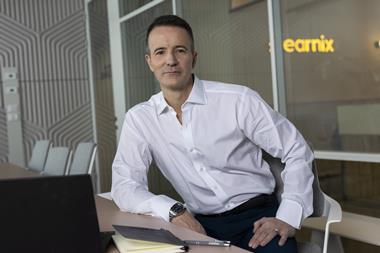Insurance Times lead researcher Savan Shah speaks with Dave Bertolin, Principal Broker of Canada’s Broker Trust Insurance Group on the technological change sweeping the industry, Applied Systems’ Epic platform and how to embrace digital transformation whilst remaining personable with customers.

Tell us a little about yourself and how you entered the insurance world?
“I started in 2007 out of University, ‘Brokers Trust Insurance Group’ is my father’s firm which started in 1963, roughly having 105 employees with $70m in premium. 60% of that personal lines, 40% in commercial lines. We have a life and benefits side which is about 5 years old, so still in its infancy.
I started from data entry, personal lines service, commercial lines service and because everyone else didn’t want to or had a lack of understanding, I self-appointed myself as the IT guy and now I project manage all the IT and finance side of the business.”
Brokers face tough choices regarding the broker management system they implement in their brokerage. Why did you choose Applied Epic?
“I will use an auto analogy when describing our decision. If I was going to buy an Aston Martin, I could buy it off the lot pre-built or I can buy all 50,000 pieces and put it together the way I want it. That was what Applied Epic was to us, we used it as an opportunity to fully review our whole business model from the ground up and built the system around our business instead of taking something out of the box and building our business around a piece of software.”
What did you anticipate would be the biggest concern for your colleagues when rolling out this digital strategy?
“Change! Plain and simple! Of the 105 employees we have about 60 who have been with us for over 20 years, some over 30 years and one that is soon to hit 45 years in 2018!
The change management piece for us was a big concern. Probably the biggest challenge was to get employees engaged and trying to get them to see the benefits of the software and how we need it now because customers demand it.
It’s simple and evident when you look at employees and the way they look at their bank statements and other things through their smart phones, but never thinking about it from our consumers side, the clients whom they service on a day-to-day basis. In Canada, the insurance industry has managed their business in specific – often inefficient – ways for a long time. When I started in 2007 in data entry, everyone was still using t-files and if you don’t know what that is that is basically you are printing out a piece of paper and sticking it in a folder. So, from then till now we have made a huge transformation and they have become accustom to it but getting people to buy into that change was difficult.
A broker I spoke to recently spoke of her dislike for etrading, stating she has been conducting business in a very traditional way for over 30 years, how do you convince someone with this thinking to embrace change sweeping the insurance industry .
We really emphasized the benefits that would make their jobs easier, what we found is a lot of these people kept hammering on about losing this and that, but we conveyed all the things they were gaining. Our rhetoric in meetings was always this is what you are going to gain, here’s how it is going to help your job, here’s how it’s going to make you do things easier and then we got them engaged.
Through the planning process, the ones that we knew might give us resistance we put them in lead positions. For example, if they came from the accounting side, we said you are going to lead that giving them direct responsibility and input into the change that was occurring.
One surprising thing that we did find was the individuals we thought were going to be the champions of the change ended up being the biggest resisters and the ones we thought would have the hardest time ended up being the real champions.” All in all, we are very proud of everyone on the team as they all showed tremendous persistence throughout the entire process, and it’s that type of dedication that made the difference.
Looking back on that year of change, was there anything that you would have done differently?
“The biggest issue for us was that we tried to do too much too fast. I would have delayed it a few months to keep within a one -year time frame, we squeezed it all in within eight months.”
Many brokers commented in last year’s Insurance Times Etrading survey that they would like to move to a new broker management system; however, the cost was a big restriction in doing so. How did you convince brokers that this was a worthwhile investment?
“The biggest thing we saw was cost savings. A lot of the automation in the back end of Applied Epic allowed us to grow with our existing employee base rather than hiring additional people. So even though for us it was costly to switch in the end the fact that we were able to grow, not hire and use the software to do a lot of those functions made financial sense.
Many of the benefits realised were on the back-end accounting which made the software quickly viable. The sales and service capabilities on the front end provided additional value which has been released with increased retention rates.”
What do you think will happen to those brokerages that don’t adopt technological software change vs those who embrace new ways of managing their brokerage and customers?
“2-part answer to this.
In Canada and similarly to the UK, there are a lot of smaller town brokerages that are very deep in the community. So, from that perspective these brokerages can be stuck in their ways they see the clientele that’s there. That clientele may or may not leave them, I think the chance of that clientele leaving them for a digital broker that is forward thinking is probably a lot less. However, when you get into the more urban areas that have highly connected customers using mobile phones (I mean you can’t get on the train without everyone looking down at their phone), no one is having to talk anymore then yes in that kind of atmosphere and market, if you are not changing then you will start losing clients.
To get them to change, the old saying you can lead a horse to water but you can’t make them drink. For us what kind of did it, you physically must show the team the entire process, here’s how it benefits you, here’s what you’ll save, gain etc and hope they will accept and embrace it.”
How do you maintain that balance between the use of technology and providing personable service to your customers?
“In the new business process, we are still all about that interaction up front, so although we might have ads online directing consumers to conduct a comparative quote on any device, we still speak to them. We remain very personable on the acquisition side, offering policy advice and introducing the technology and digital on the service side for all the policy changes and things that occur throughout the term.
Our renewal process is still very personable –We recently began leveraging integrations with Applied Epic for an email CRM, automatic personalised email going out now as policies download, renew etc so trying to keep that personal touch on some side, but on service side the little things that cost money don’t generate revenue – we are trying to digitalise that side.”
If you could pick one aspect of the Applied Epic that has benefited the operational side of the business what has stood out to you?
“In my area, it would be the accounting and reporting side from being able to track performance, employee workload and more. Download and being able to import the excel spreadsheets with billing statements for accounting enables us to eliminate manual processes while keeping a clear picture of the business.
From the service and client side, the ability to customise our workflows and monitor data more efficiently that our customer service representatives are putting in the system, which then translates and integrates into our portals and apps. That has made our data much more reliable.”
What has stood out to your account handlers that has improved their job role since using Applied Epic?
“Ease and access of information. The ability to easily start processes in the software – whether it is in the mobile app or online. Having information easily accessible at your fingertips, being able to answer questions from clients and being able to look up things quickly is what stood out to them.
It also means they can connect to client information at any time from any location, empowering our salesforce to be out there on the road doing what they do best!”
What advice would you give an 18-year-old version of yourself if you could go back in time?
“Learn people, I came out of university full of adrenaline and that came to a screeching halt very quickly. You realise that people aren’t just going to do what you say because you think it is a good idea. Really learning to understand and communicate with people would be something if I had to go back I would concentrate on earlier in my career.”













































No comments yet